Secrets of the Peresvet complex: how does the Russian laser sword work?
Since its inception, lasers have come to be regarded as weaponspotentially capable of revolutionizing hostilities. Since the mid-XNUMXth century, lasers have become an integral part of science fiction films, weapons of super-soldiers and interstellar ships.
However, as often happens in practice, the development of high-power lasers has encountered great technical difficulties, which have led to the fact that so far the main niche of military lasers has been their use in reconnaissance, aiming and target designation systems. Nevertheless, work on the creation of combat lasers in the leading countries of the world practically did not stop; programs for creating new generations of laser weapons replaced one another.
Earlier we looked at some stages of the development of lasers and the creation of laser weapons, as well as development stages and the current situation of creating laser weapons for the air force, laser weapons for ground forces and air defense, laser weapons for the navy. At the moment, the intensity of laser weapons programs in different countries is so high that they no longer have doubts about their appearance on the battlefield. AND it will be far from easy to defend against laser weapons, as it seems to some, at least they won’t manage to get along with silverfish.
If you look closely at the development of laser weapons in foreign countries, you can see that most of the proposed modern laser systems are implemented on the basis of fiber and solid-state lasers. Moreover, for the most part, these laser systems are designed to solve tactical problems. Their output power currently lies in the range from 10 kW to 100 kW, but in the future it can be increased to 300-500 kW. In Russia, information on the work on creating tactical-class combat lasers is practically absent; we will talk below about the reasons why this is happening.
On March 1, 2018, during a message to the Federal Assembly, among other breakthrough weapon systems, Russian President Vladimir Putin announced the “Peresvet” combat laser complex (BLK), the dimensions and intended purpose of which imply its use for solving strategic tasks.
The Peresvet complex is surrounded by a veil of secrecy. The characteristics of other latest types of weapons (complexes “Dagger”, “Vanguard”, “Zircon”, “Poseidon”) were to some extent voiced, which partly allows us to judge their purpose and effectiveness. At the same time, no specific information was provided on the Peresvet laser complex: neither the type of laser installed, nor the energy source for it. Accordingly, there is no information about the power of the complex, which, in turn, does not allow us to understand its real capabilities and the goals and objectives set for it.
Combat laser complex "Peresvet"
Laser radiation can be obtained in dozens, rather even in hundreds of ways. So what is the method of obtaining laser radiation implemented in the latest Russian BLK "Peresvet"? To answer the question, we will consider various options for the execution of the Peresvet BLK and evaluate the degree of probability of their implementation.
The information below is the author’s assumptions based on information from open sources available on the Internet.
BLK "Peresvet". Execution No. 1. Fiber, solid state and liquid lasers
As mentioned above, the main trend in the creation of laser weapons is the development of complexes based on fiber optic. Why is this happening? Because based on fiber lasers it is easy to scale the power of laser systems. Using a package of modules of 5-10 kW, receive output radiation with a power of 50-100 kW.
Can the Peresvet BLK be implemented on the basis of these technologies? It is highly likely that no. The main reason here is that during the years of perestroika, the leading developer of fiber lasers, the IRE-Polyus Scientific and Technical Association, "formed the basis for the formation of transnational IPG Photonics Corporation, registered in the USA and now the world leader in the industry," escaped from Russia. high power fiber lasers. The international business and the main place of registration of IPG Photonics Corporation implies its strict submission to US law, which, taking into account the current political situation, does not imply the transfer of critical technologies to Russia, which, of course, include the creation of powerful lasers.
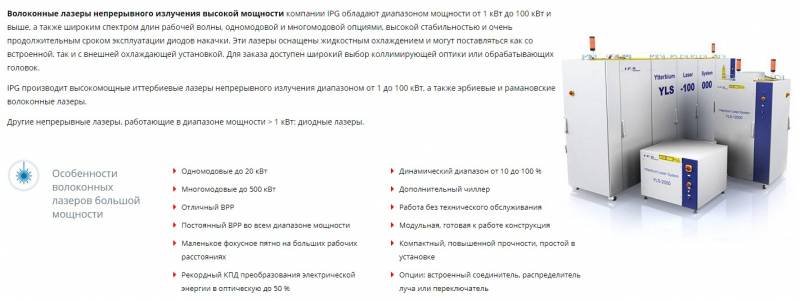
IPG Photonics produces YLS fiber lasers with power up to 100 kW, which can be integrated into assemblies with a total power of up to 500 kW. IPG Photonics laser efficiency reaches 50%
Can fiber lasers be developed in Russia by other organizations? Perhaps, but it is unlikely, or while these are products of low power. Fiber lasers are a profitable commercial product, so the lack of powerful domestic fiber lasers on the market most likely indicates their actual absence.
A similar situation is with solid-state lasers. Presumably, it is more difficult to implement a batch solution, it is nevertheless possible, and in foreign countries it is the second most widely used solution after fiber lasers. Information about high-power industrial solid-state lasers produced in Russia could not be found. Solid state lasers are underway in Institute of Laser Physical Research RFNC-VNIIEF (ILFI), so theoretically a solid-state laser in the Peresvet BLK can be installed, but in practice this is unlikely, since at first more compact laser weapons or experimental installations would most likely appear.
There is even less information about liquid lasers, although there is information that a combat liquid laser is being developed (was it developed, but was rejected?) In the US as part of the HELLADS (High Energy Liquid Laser Area Defense System, “High Energy Liquid Laser Defense System” ) Presumably liquid lasers have the advantage of the possibility of cooling, but lower efficiency (efficiency) compared with solid-state lasers.
In 2017, information appeared about the placement of the Polyus Research Institute for a tender for an integral part of scientific research work (R&D), the purpose of which is the creation of a mobile laser complex to combat small-sized unmanned aerial vehicles (UAVs) in daytime and twilight conditions. The complex should consist of a tracking system and construction of flight paths of the target, providing target designation for the laser radiation guidance system, the source of which will be a liquid laser. Of interest is the requirement specified in the TOR for the creation of a liquid laser, and at the same time the requirement for the presence of a fiber power laser in the complex. Either this is a typo, or a new type of fiber laser with a liquid active medium in the fiber has been developed (is being developed), combining the advantages of a liquid laser for the convenience of cooling and a fiber laser for bundling emitter packages.
The main advantages of fiber, solid-state, and liquid lasers are their compactness, the ability to batch increase power, and the ease of integration into various weapons classes. All this does not look like the Peresvet laser, which was clearly developed not as a universal module, but as a solution made "with a single goal, according to a single plan." Therefore, the probability of the implementation of the Peresvet BLK in Execution No. 1 on the basis of fiber, solid-state and liquid lasers can be estimated as low.
BLK "Peresvet". Execution No. 2. Gas-dynamic and chemical lasers
Gas-dynamic and chemical lasers can be considered an obsolete solution. Their main disadvantage is the need for a large number of consumable components necessary to maintain a reaction that provides laser radiation. Nevertheless, it was chemical lasers that were most developed in the development of the 70s - 80s of the XX century.
Apparently, on gas-dynamic lasers, whose operation is based on adiabatic cooling of heated gas masses moving at a supersonic speed, continuous radiation powers of more than 1 megawatt were first obtained in the USSR and the USA.
In the USSR, from the mid-70s of the XX century, an A-60 airborne laser system was developed on the basis of the Il-76MD aircraft, presumably armed with a RD0600 laser or its equivalent. Initially, the complex was intended to deal with automatic drifting balloons. As weapons, a continuous gas-dynamic megawatt-class CO laser developed by the Khimavtomatiki Design Bureau (KBHA) was to be installed. As part of the tests, a family of GDL bench models with a radiation power of 10 to 600 kW was created. The disadvantages of GDL is the large radiation wavelength of 10,6 μm, which ensures high diffraction divergence of the laser beam.
Even higher radiation powers were obtained with deuterium fluoride chemical lasers and oxygen-iodine (iodine) lasers (CIL). In particular, within the framework of the program Strategic Defense Initiative (SDI) several megawatts of deuterium fluoride chemical laser were created in the USA, as part of the program US National Missile Defense (NMD) was developed aviation complex Boeing ABL (AirBorne Laser) with an oxygen-iodine laser with a power of about 1 megawatt.
At VNIIEF, the world's most powerful pulsed chemical laser for the reaction of fluorine with hydrogen (deuterium) was created and tested, a pulsed-periodic laser was developed with a radiation energy of several kJ per pulse, a pulse repetition rate of 1–4 Hz, and a radiation divergence close to the diffraction limit and efficiency of about 70% (the highest achieved for lasers).
Between 1985 and 2005 lasers based on the non-chain reaction of fluorine with hydrogen (deuterium) were developed, where sulfur hexafluoride SF6 dissociating in an electric discharge (photodissociation laser?) was used as a fluorine-containing substance. To ensure long-term and safe operation of the laser in a pulse-periodic mode, installations with a closed cycle for changing the working mixture have been created. The possibility of obtaining a divergence of radiation close to the diffraction limit, a pulse repetition rate of up to 1200 Hz and an average radiation power of several hundred watts in an electric discharge laser based on a non-chain chemical reaction is shown.
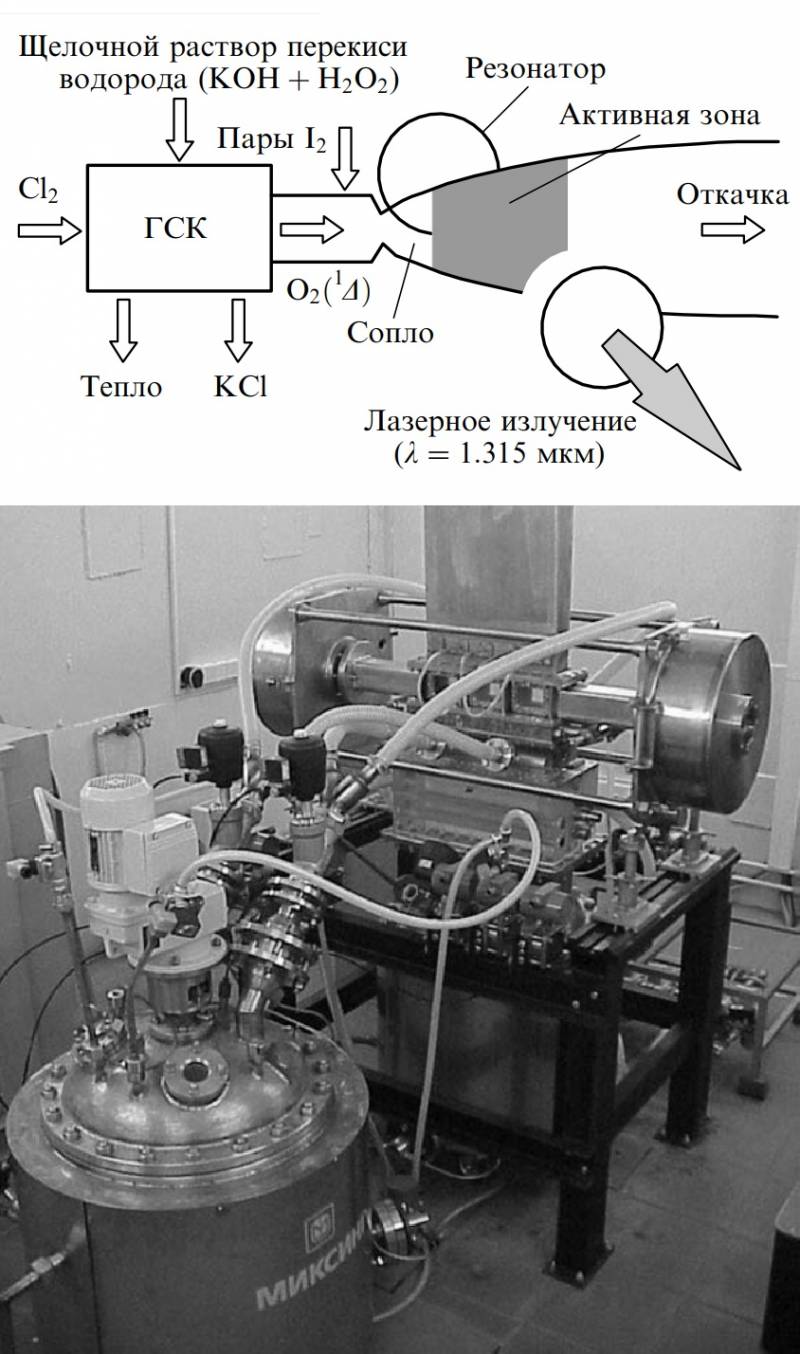
Functional diagram of chemical KIL and continuous chemical KIL with a power of 15 kW produced by the company "Laser Systems"
Gas-dynamic and chemical lasers have a significant drawback, in most decisions it is necessary to replenish the stock of “ammunition,” often consisting of expensive and toxic components. It is also necessary to clean the exhaust gases resulting from the operation of the laser. In general, it is difficult to call gas-dynamic and chemical lasers an effective solution, and therefore the transition of most countries to the development of fiber, solid-state, and liquid lasers is due to.
If we talk about a laser based on the nonchain reaction of fluorine with deuterium dissociating in an electric discharge with a closed cycle of changing the working mixture, then in 2005 powers of about 100 kW were obtained, it is unlikely that during this time they could be brought up to a megawatt level.
In relation to the Peresvet BLK, the question of installing a gas-dynamic and chemical laser on it is quite controversial. On the one hand, significant developments have remained in Russia for these lasers. Information appeared on the Internet about the development of an improved version of the A 60 - A 60M aviation complex with a 1 MW laser. It is also said about placing the Peresvet complex on an aircraft carrier, ”which may be the second side of the same coin. That is, at first they could make a more powerful ground-based complex based on a gas-dynamic or chemical laser, and now, following the beaten path, install it on an aircraft carrier.
The creation of Peresvet was carried out by specialists from the nuclear center in Sarov, at the Russian Federal Nuclear Center - the All-Russian Scientific Research Institute of Experimental Physics (RFNC-VNIIEF), at the already mentioned Institute of Laser-Physical Research, which, among other things, is developing gas-dynamic and oxygen-iodine lasers .
On the other hand, whatever one may say, gas-dynamic and chemical lasers are outdated technical solutions. In addition, information is actively circulating on the presence of a nuclear power source in the Peresvet BLK for powering the laser, and in Sarov they are more engaged in creating the latest breakthrough technologies, often related to nuclear energy.
Based on the foregoing, it can be assumed that the probability of the implementation of the Peresvet BLK in Execution No. 2 based on gas-dynamic and chemical lasers can be estimated as moderate.
Nuclear-pumped lasers
Since the late 1960s, work began on the creation of high-power nuclear-pumped lasers in the USSR. Initially, the specialists of VNIIEF, IAE im. Kurchatov and the Research Institute of Nuclear Physics, Moscow State University. Then they were joined by scientists at MEPhI, ¬VNIITF, IPPE and other centers. In 1972, VNIIEF excited a mixture of helium and xenon with uranium fission fragments using a VIR 2 pulsed reactor.
In the years 1974-1976. experiments are being conducted at the TIBR-1M reactor, in which the laser radiation power was about 1-2 kW. In 1975, on the basis of the VIR-2 pulsed reactor, a two-channel laser unit LUNA-2 was developed, which in 2005 still worked, and it is possible that it still works. In 1985, a neon laser was pumped for the first time in the world at the LUNA-2M installation.
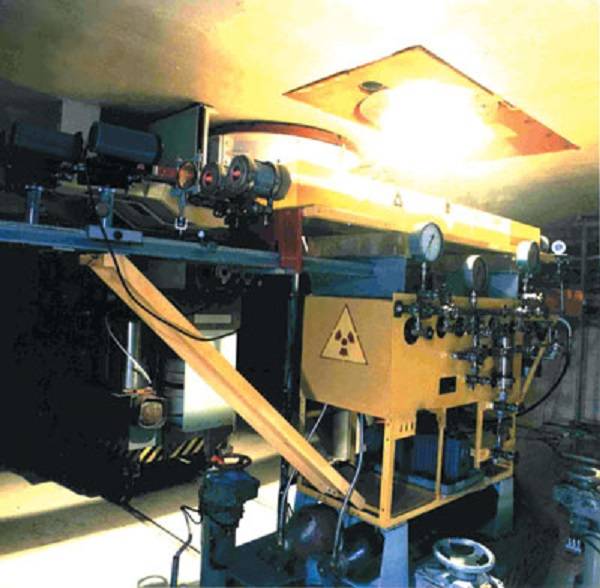
LUNA-2M installation
In the early 1980s, VNIIEF scientists, to create a nuclear-laser element operating in continuous mode, developed and manufactured a 4-channel laser module LM-4. The system is excited by a neutron flux from the BIGR reactor. The duration of the generation is determined by the duration of the radiation pulse of the reactor. For the first time in the world, continuous generation in nuclear-pumped lasers was demonstrated in practice and the efficiency of the transverse gas pumping method was demonstrated. The laser power was about 100 watts.
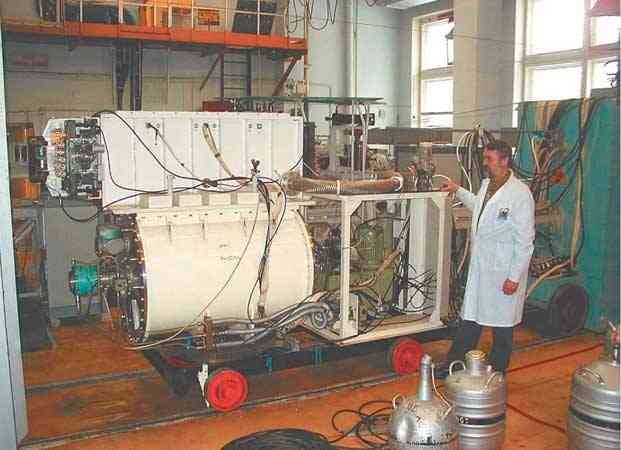
Installation LM-4
In 2001, the LM-4 installation was modernized, receiving the designation LM-4M / BIGR. The operation of a multi-element nuclear laser device in continuous mode was demonstrated after 7 years of preservation of the installation without replacing the optical and fuel cells. The LM-4 installation can be considered as a prototype reactor-laser (RL), possessing all its qualities, except for the possibility of a self-sustaining nuclear chain reaction.
In 2007, instead of the LM-4 module, the eight-channel laser module LM-8 was put into operation, which provided for the sequential addition of four and two laser channels.
The laser reactor is an autonomous device that combines the functions of a laser system and a nuclear reactor. The active zone of a laser reactor is a set of a certain number of laser cells placed in a certain way in a neutron moderator matrix. The number of laser cells can range from hundreds to several thousand pieces. The total amount of uranium is from 5-7 kg to 40-70 kg, linear dimensions 2-5 m.
At VNIIEF, preliminary estimates were made of the main energy, nuclear-physical, technical and operational parameters of various versions of laser reactors with a laser radiation power of 100 kW and above, operating from fractions of a second to continuous operation. Reactor lasers with heat storage in the reactor core at start-ups, the duration of which is limited by the permissible heating of the AZ (heat-capacitive radar) and continuous radar with the removal of thermal energy outside the AZ
Presumably, a laser reactor with a laser power of about 1 MW should contain about 3000 laser cells.
In Russia, intensive work on nuclear-pumped lasers was carried out not only at VNIIEF, but also at the Federal State Unitary Enterprise State Scientific Center of the Russian Federation - A.I. Leipunsky ”, as evidenced by patent RU 2502140 for the creation of a“ laser-laser reactor with direct pumping of fission fragments. "
Specialists of the SSC RF IPPE developed an energy model of a pulsed reactor-laser system - an optical nuclear-pumped quantum amplifier (OKUYAN).
Remembering the statement of the Deputy Minister of Defense of Russia Yuri Borisov in last year’s interview with the newspaper Krasnaya Zvezda (“Laser systems have come into service, which make it possible to disarm a potential enemy and hit all those objects that serve as the target for the laser beam of this system. Our nuclear scientists have learned how to concentrate the energy needed to destroy the enemy’s respective weapons in almost a few seconds”) ), we can say that the Peresvet BLK is equipped not with a small-sized nuclear reactor that feeds the laser with electric energy, but with a laser reactor in which the fission energy is directly converted to laser radiation.
Only the aforementioned proposal makes it possible to place Peresvet BLK on an airplane. No matter how you ensure the reliability of the carrier aircraft, there is always a risk of an accident and a plane crash with the subsequent spread of radioactive materials. However, it is possible that there are ways to prevent the spread of radioactive materials when the carrier falls. And the flying petrel in a cruise missile cruise missile we already seem to have.
Based on the foregoing, it can be assumed that the probability of the implementation of the Peresvet BLK in version No. 3 based on a nuclear-pumped laser can be estimated as high.
It is not known whether the installed laser is pulsed or continuous. In the second case, the time of continuous operation of the laser and the breaks that must be carried out between operating modes are in question. I would like to hope that a continuous laser reactor is installed in the Peresvet BLK, the operating time of which is limited only by the supply of refrigerant, or not limited if the cooling is provided in any other way.
In this case, the output optical power of Peresvet BLK can be estimated in the range of 1-3 MW with the prospect of increasing to 5-10 MW. It is hardly possible to hit a nuclear warhead even with such a laser, and a plane, including an unmanned aerial vehicle, or a cruise missile is quite. It is also possible to ensure the defeat of almost any unprotected spacecraft in low orbits, and it is possible to damage sensitive elements of spacecraft in higher orbits.
Thus, the first target for Peresvet BLK may be sensitive optical elements of the US missile attack warning satellites, which can act as an element missile defense in case of application by the USA sudden disarming strike.
Conclusions
As we said at the beginning of the article, there are a fairly large number of ways to obtain laser radiation. In addition to the ones discussed above, there are other types of lasers that can be effectively used in military affairs, for example, a free-electron laser, in which it is possible to widely vary the wavelength up to soft x-ray radiation and which just needs a lot of electric energy produced by small-sized nuclear reactor. Such a laser is being actively developed in the interests of the US Navy. However, the use of a free electron laser in Peresvet BLK is unlikely, because at present there is practically no information on the development of such lasers in Russia, apart from participation in Russia in the European free electron x-ray program.
It must be understood that the assessment of the probability of applying one or another solution to the Peresvet BLK is rather arbitrary: the presence of only indirect information obtained from open sources does not allow us to draw conclusions with a high degree of reliability.
It is possible that the conclusion about the high probability that the Peresvet BLK uses a laser with a nuclear pump is partially made not only on the basis of objective factors, but also on the underlying desire of the author. For if Russia really created a laser with a nuclear pumping power of megawatts or more, this opens up extremely interesting prospects for creating weapons systems that can radically change the face of the battlefield. But we will talk about this in another article.
PS In order to exclude questions and disputes about the influence of the atmosphere and weather on the operation of lasers, it is highly recommended to study the book by A. S. Boreisho “Powerful mobile chemical lasers”, at least chapter 6 entitled “Propagation of laser radiation at operational distances”.
- Andrey Mitrofanov
- strana-rosatom.ru, ruspekh.ru, “Powerful mobile chemical lasers. A.S. Boreisho ”, element114.narod.ru, book.sarov.ru, cosmos.mirtesen.ru, vniief.ru, atominfo.ru
- Laser weapons: technology, history, status, prospects. Part of 1
Laser weapons: prospects in the air force. Part of 2
Laser weapons: ground forces and air defense. Part of 3
Laser weapons: navy. Part of 4
Resist light: protection from laser weapons. Part of 5
Laser weapons on combat aircraft. Is it possible to resist him?
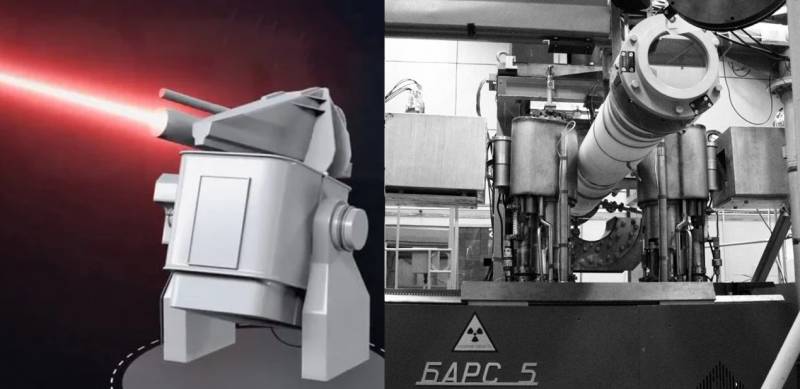
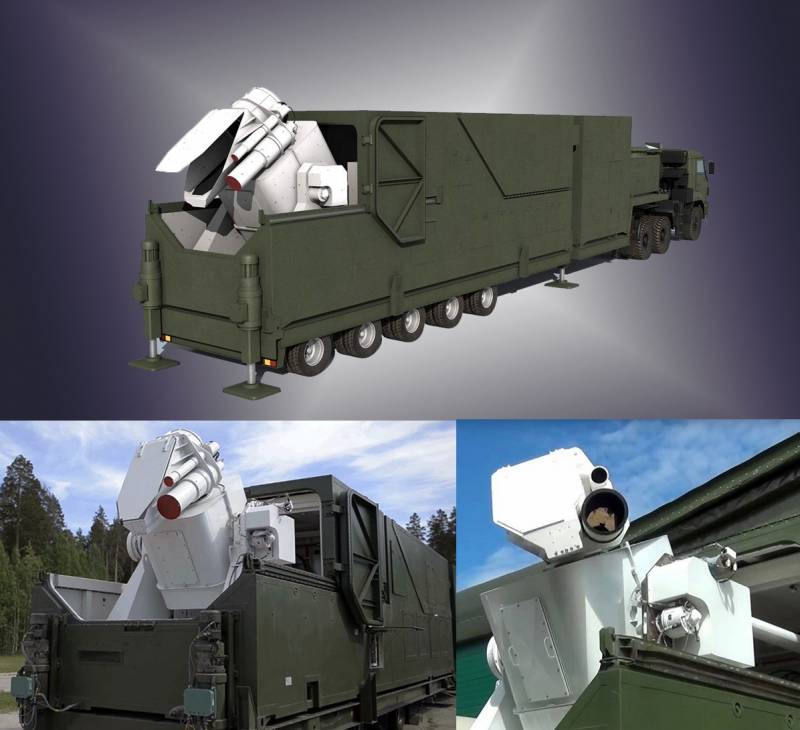
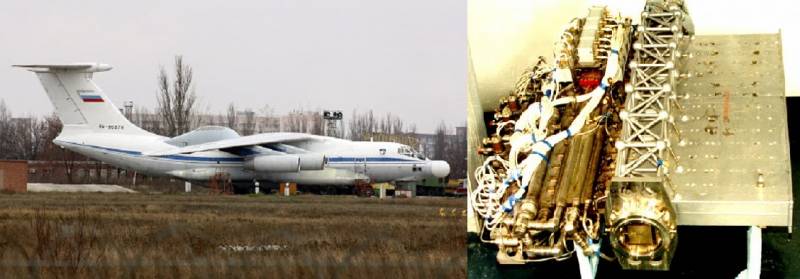
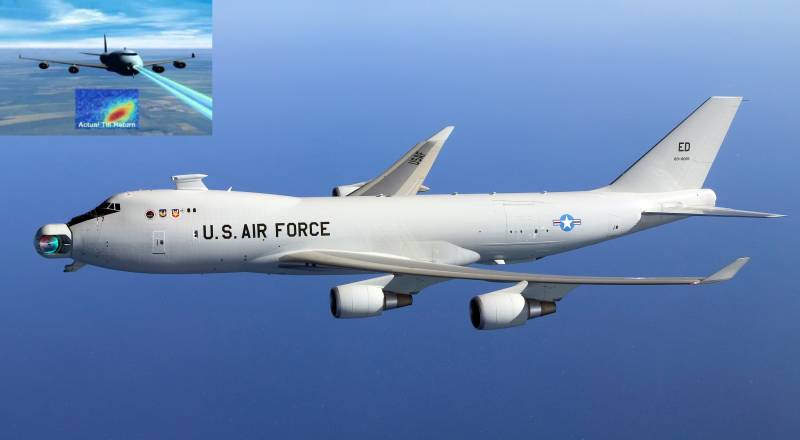
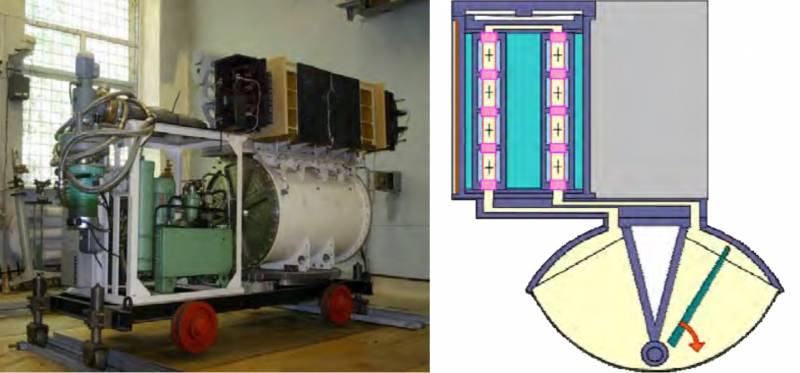
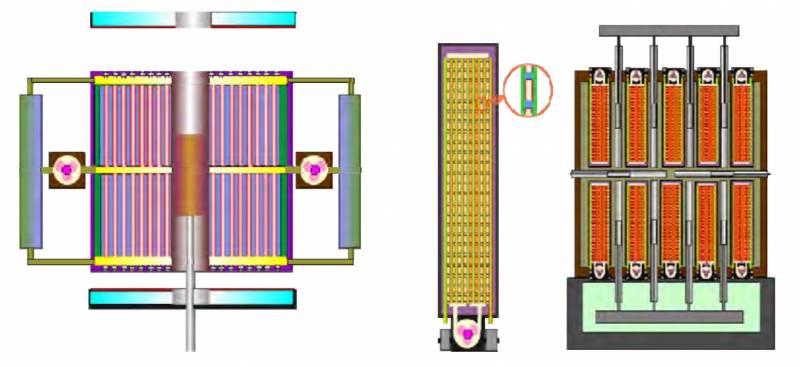
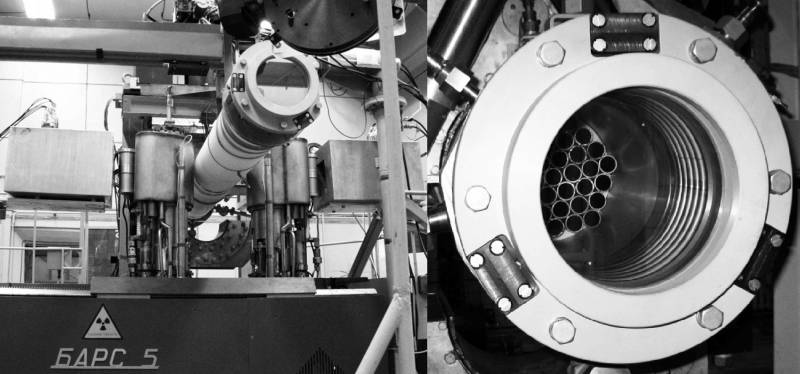
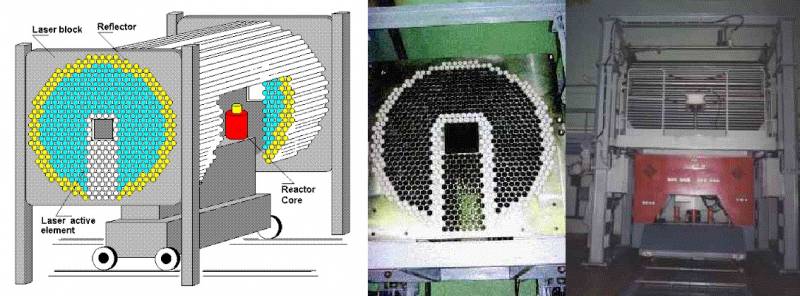
Information